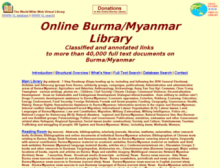Resource information
Executive Summary:
"Myanmar has been engaged in a process of political change since 2011. A central goal of these reforms
has been the attempt to resolve political conflicts between ethnic armed organisations (EAOs) and the
Myanmar Government. Talks began under the ‘civilian
government’ led by Thein Sein and have continued
under the National League of Democracy (NLD)
-
led Government. However, several years of talks have
produced little concrete progress.
This is a complex peace process, which has only the partial inclusion
of Myanmar’s many ethnic armed
organisations and which is being conducted in a climate of continuing conflict and state violence and
continuing tensions between the Burman majority and other ethnic groups. This is evident in large
-
scale
displacement from R
akhine State (where more than 300,000 refugees fled to Bangladesh in September
2017) and in Kachin and northern Shan States (where more than 119,000 people have been displaced since
2011). There is also an urgent emerging problem of large
-
scale development
and land acquisition projects
creating further displacement.
It is important not to be naïve about the scale of the challenges in Myanmar’s peace process, or indeed
about the possibility that the peace process may break down entirely. However, it is a
lso valuable to
consider what would be required to maximise the chances of a successful peace process. There is no
formula to determine why some peace processes work while others fail, but the chances of building a
sustainable peace are substantially enhan
ced when the process genuinely engages with and seeks to
correct the inequalities and injustice that gave rise to conflict. For Myanmar, that must include addressing
the causes and consequences of displacement
.
This working paper sets out the context an
d experience of displacement in and from Myanmar. It identifies
a number of areas that must be addressed,
including:
-
The process of drafting a peace agreement, and displacement
-
specific provisions to include in a
peace agreement;
-
The timing, design and implementation of return and reintegration of displaced populations;
-
Wider issues of legal protection, land governance and restitution.
The working paper also identifies some cross
-
cutting themes, including the need to recognise a
relationship
between displacement and other aspects of peacebuilding (such as political autonomy for ethnic areas and
land governance); the necessity of ensuring that displaced people themselves are central to the process of
policy design, ideally through
institutionalised mechanisms for dialogue, consultation and representation;
and the importance of securing continued funding to support refugees and IDPs with a continuing need of
international protection...


